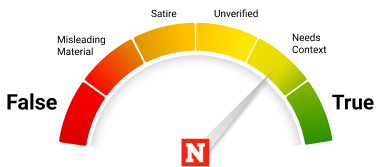Critics of Donald Trump have long suggested that the former Republican president's four-year term in the White House had a lopsided effect on the national debt.
Such criticism has returned after newly elected House Speaker Kevin McCarthy (R-CA) vowed to eliminate "wasteful" Washington D.C. spending and stop the rising national debt now the GOP has regained control of the lower chamber.
But what do the numbers say?

The Claim
In a tweet on January 17, former Republican congressman turned MSNBC contributor David Jolly claimed that around a quarter of the country's $31 trillion national debt occurred while Trump was president.
Jolly's comment was in reply to McCarthy, who wrote: "House Republicans are on a mission to end wasteful Washington spending. From now on, if a federal bureaucrat wants to spend it, they have to come before us to defend it."
In response, Jolly tweeted: "For context, roughly 25% of our total national debt incurred over the last 230 years actually occurred during the 4 years of the Trump administration. That's right. 25% of our entire national debt, all during the Trump years."
The tweet had more than 2.5 million views, 13,600 retweets, and 26,300 favorites at the time of writing.
For context, roughly 25% of our total national debt incurred over the last 230 years actually occurred during the 4 years of the Trump administration. That's right. 25% of our entire national debt, all during the Trump years. https://t.co/xcNfpiZ1It
— David Jolly (@DavidJollyFL) January 18, 2023
The Facts
Just like McCarthy is doing now in his new role as House Speaker, Trump also vowed to tackle the national debt while he was president.
When Trump entered office in January 2017, the national debt was nearly $19.9 trillion, according to U.S. Treasury data.
The debt did lower slightly during the first few months of Trump's presidency, between the first and second quarters of 2017, but then continued to rise for the next three years, hitting just over $26.9 trillion by the end of the fiscal year in 2020.
One major reason for this $7 trillion jump was the huge amount of borrowing for the government's response to the global coronavirus pandemic, which upended the economy and triggered a recession.
In a three-month period alone in 2020, the Treasury announced that it would need to borrow $3 trillion in order to cover the costs of the COVID relief plans. While Trump was president during this time, this spending had bipartisan support in Congress.
However, one Trump and Republican-driven policy in particular added significantly to the national debt: The Tax Cuts and Jobs Act (TCJA) 2017.
In 2018, the Congressional Budget Office predicted these tax cuts would add nearly $1.9 trillion to the total deficit by 2028. Governments are in deficit when they spend more money than they generate in revenue, meaning they must borrow money to plug the gap—adding to the national debt pile.
According to the most recent update from the Treasury, the country's current national debt currently stands at $31.4 trillion.
The $7 trillion increase in national debt under Trump's presidency is not entirely unique. When Barack Obama entered office in January 2009, the debt stood at $11.1 trillion as the country continued to feel the effects of the 2008 financial crash.
By the end of Obama's final year in office in 2016, the debt was almost $19.9 trillion—an increase of $8.8 trillion, albeit accumulated over the course of eight years and during a longer recession than Trump's presidency experienced.
In a follow-up tweet, Jolly explained that he used "back of the napkin math" to come up with the 25 percent debt increase figure.
"210 years, 5 trillion. 8 years under Bush, now 10t. 8 years under Obama, now 20t. 4 years under Trump, now 28t," Jolly wrote. "COVID was an amplifier of 3t, but the pattern continued regardless."
However, it appears that Jolly was using figures from the end of Trump's presidency in 2021, when the debt was at $28.1 trillion, and then rounded up the debt when he entered office in 2017 to $20 trillion, giving an increase of $8 trillion under Trump.
This $8 trillion figure given by Jolly would amount to just over 25 percent of the current $31.4 trillion debt.
Newsweek has reached out to Jolly for comment.
The Ruling

Needs Context.
Using official Treasury figures from the fiscal year, the national debt increased by $7 trillion during Trump's presidency.
Given the current debt is just over $31.4 trillion, Jolly's self-described "rough" 25 percent figure claimed by Jolly is imprecise based on Treasury data; it is actually 22.3 percent of the current total.
Jolly's own napkin math, putting Trump's rise in national debt at $8 trillion, is slightly higher than a quarter of the $31.4 trillion figure, coming in at 25.5 percent.
It should be noted that much of the debt accrued during the Trump presidency occurred as a consequence of the federal response to the global pandemic that severely hurt the economy. This COVID relief was approved by Congress on a bipartisan basis.
FACT CHECK BY NEWSWEEK
Uncommon Knowledge
Newsweek is committed to challenging conventional wisdom and finding connections in the search for common ground.
Newsweek is committed to challenging conventional wisdom and finding connections in the search for common ground.
About the writer
Ewan Palmer is a Newsweek News Reporter based in London, U.K. His focus is reporting on US politics, domestic policy ... Read more





